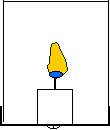
A Candle burns in a plastic container. It is screwed onto the
lid.

A Candle burns in a plastic container. It is screwed onto the
lid.
Introduction
Observe what happens to a candle flame in freefall.
Material
Assembly
Attach the candle to the lid.
There are many ways to do this. Try double sided tape (which may not stick to the wax but many short candles come in a metal holder.)
Or stick a pushpin through the lid, and then push the candle onto the pin.
Or screw a short fat wood screw through the lid and into the base of the candle.
To Do and Notice
Light the candle.
Attach the jar to the lid. Screw on the peanut butter container, or snap on the deli container.
Hold the candle in the jar as high as you can, and drop it onto the pillow or into the hands of a partner.
What do you see?
Many people see that the candle becomes dim shortly after it begins to fall.
Often the candle goes out completely as it is caught.
Try dropping the candle from a greater height in a dim room.
Often the question arises as to whether the candle burns up all the air in the container.
What experiment could you do to test this idea? See Air Supply for an answer.
Why does the candle get dim?
What's Going On?
In order to continue burning, a candle needs to
combine its vaporized wax fuel with oxygen producing heat, carbon
dioxide, water vapor, and soot.
If the supply of oxygen is removed the candle will go out.
If the supply of oxygen is reduced the candle will get
dim.
As the candle burns normally the hot exhaust products rise due to convection giving the candle flame its classic shape. As the exhaust gasses rise, oxygen rich air flows in from beneath the candle to replace the departing gasses.
The inflowing oxygen reacts with the vaporized candle wax producing a hot blue zone at the bottom of the flame. The incandescent soot flows up with the exhaust gasses emitting bright yellow light.
When the candle-in-a-bottle goes into freefall convection ceases.
In order for hot air to rise, there must be an "up" without gravity there is no "up."
In a freely falling frame of reference, objects behave as if there were no net gravity force.
Thus there is no convection, and the candle's supply of oxygen is reduced causing the flame to dim.
If the bottle stops suddenly at the bottom of its fall, the inertia of the falling air causes it to rush to the bottom of the bottle, this sudden rush of air can cool the flame and extinguish it. It also restores oxygen to the candle wick, if the wick is large enough to remain incandescent it can then re-ignite in the presence of the renewed oxygen.
Going Further
Why do you need the bottle? Try dropping the candle with the lid alone.
Try and open top bottle.
Try candles with different diameter wicks.
Etc.
Experiments with candles in the space shuttle show that candles can continue to burn in freefall, however the oxygen flows into the candle by diffusion resulting in a dim blue spherical flame. (Image)
To find out how long it takes for the candle to burn up the oxygen in the jar, simply light the candle and time how long it takes to go out. In a half pint peanut butter jar my candle burned for over 20 seconds, which was plenty of time to complete the freefall experiment.
|
Scientific Explorations with Paul Doherty |
|
5 Nov 2002 |